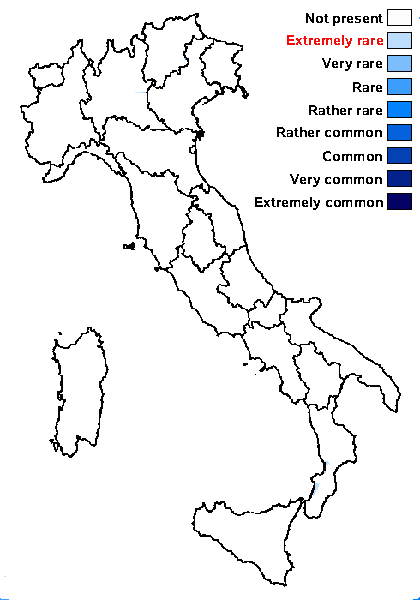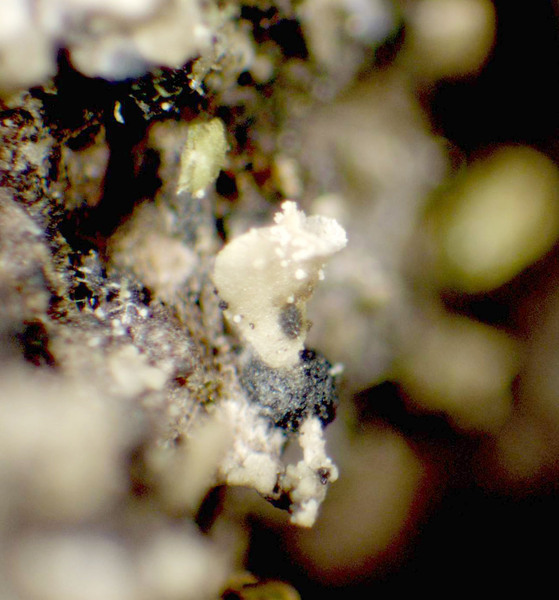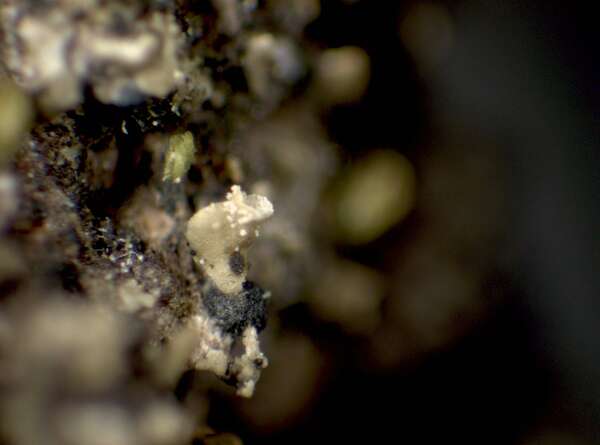Waynea adscendens V.J. Rico
Rivasgodaya, 6: 130, 1991.
Synonyms:
Distribution: S - Cal (Puntillo 1995, 1996).
Description: Thallus minutely squamulose, sorediate. Squamules 0.1-2.5 x 0.1-1.5 mm, pale green to brownish green (turning brown in the herbarium), slightly glossy, contiguous or imbricate, at first closely adpressed to the substratum and appearing subgranulose, then in part ascending to suberect, round or lobed, mostly slightly convex; lower surface whitish. Soralia laminal, at first subglobose, then splitting into part-soralia (forciniform), and finally confluent into hood-shaped to dome-shaped, 0.3-0.8 mm wide soralia surrounded by a glossy, red-brown cortex, the soredia white to pale green, 15-50 μm in diam. Upper cortex 15-150 μm thick (thicker in the sorediate parts), prosoplectenchymatous; medulla white, 80-250 μm thick, I-; lower cortex absent. Apothecia biatorine, laminal, 0.3-2 mm across, constricted at base to almost short-stalked, round to sinuous in outline, with a whitish, ochraceous or brown, flat to convex disc, and a concolorous proper margin. Proper exciple 60-100 μm wide, colourless; epithecium colourless or pale yellow, K- or K+ violet, N+ purple; hymenium colourless, 40-65 μm high, I+ blue; paraphyses mostly simple, 1-2 μm thick at base, the apical cells 2.5-35 μm wide, surrounded by a thin, pigmented, gelatinous layer; hypothecium colourless, subtended by an algal layer. Asci 8-spored, clavate, distinctly thickened at apex, with a I+ blue tholus, the outer gelatinous coat I+ pale blue, Bacidia to Biatora-type. Ascospores (1-)3-5-septate, hyaline, long-subfusiform, straight or slightly curved, (15-)20-31(-34) x (1.5-)2-3.5(-4) μm. Photobiont chlorococcoid. Spot tests: cortex and medulla K-, C-, KC-, P-. Chemistry: thallus without lichen substances; Sedifolia-grey pigment in epithecium. Note: a Mediterranean-Atlantic species found on the bark of more or less isolated, old broad-leaved trees in very humid areas, mostly in the Mediterranean belt. It is included as “Critically Endangered” in the Italian red list of epiphytic lichens (Nascimbene & al. 2013c).
Growth form: Squamulose
Substrata: bark
Photobiont: green algae other than Trentepohlia
Reproductive strategy: mainly asexual, by soredia, or soredia-like structures (e.g. blastidia)
Most common in areas with a humid-warm climate (e.g. most of Tyrrenian Italy)
Commonnes-rarity: (info)
Alpine belt: absent
Subalpine belt: absent
Oromediterranean belt: absent
Montane belt: absent
Submediterranean belt: absent
Padanian area: absent
Humid submediterranean belt: absent
Humid mediterranean belt: extremely rare
Dry mediterranean belt: absent

Predictive model
Herbarium samples
Growth form: Squamulose
Substrata: bark
Photobiont: green algae other than Trentepohlia
Reproductive strategy: mainly asexual, by soredia, or soredia-like structures (e.g. blastidia)
Most common in areas with a humid-warm climate (e.g. most of Tyrrenian Italy)
Commonnes-rarity: (info)
Alpine belt: absent
Subalpine belt: absent
Oromediterranean belt: absent
Montane belt: absent
Submediterranean belt: absent
Padanian area: absent
Humid submediterranean belt: absent
Humid mediterranean belt: extremely rare
Dry mediterranean belt: absent

Predictive model
| Herbarium samples |
 INDEX FUNGORUM
INDEX FUNGORUM
 GBIF
GBIF




